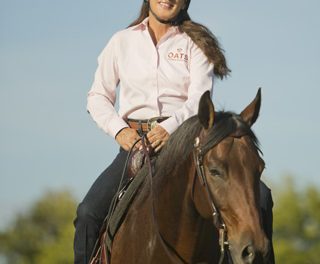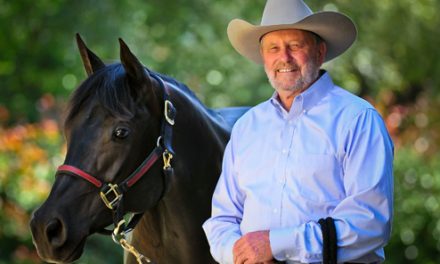Whether you are starting your horse under saddle for the first time, or re-training an older horse with bad habits, teaching your horse to soften to the bit is a foundation exercise that you will use to build up to all other aspects of your training. You may hear softening to the bit also referred to as giving to the bit, getting a horse’s face vertical, suppling a horse’s neck, or getting a horse’s face soft. These are all basically the same thing. Collection and softness are not the same thing, but you will not be able to get your horse collected if he is not soft. Collection is a product of softness. For this exercise, you will need a bridle with a snaffle bit and a saddle if you plan to complete the riding part of the exercise. I usually use a full cheek snaffle bit.
This exercise can be done from the ground or the saddle. I like to start on the ground even if I am re-training an older horse who has been ridden before. You want this exercise to be solid before you get in the saddle. Put the reins over your horse’s neck as if you were about to ride. Stand by his shoulder, and take the rein on the same side you are standing on in one hand. Place this hand on the horse’s shoulder, and use your other hand back towards the saddle area to pull the rein through your first hand if you need to make it shorter. It is impossible to get your horse soft by pulling on him. What you want to do here is put a little pressure on the rein and wait for him to soften, or give in the direction of the pressure himself. When he softens his nose, you want to see him bring his nose off center, turning his head towards you. You also want him to flex at the poll, the place just behind the ears (about where your bridle path starts). When your horse tips his nose off center and flexes at the poll, release the rein immediately to reward him.
One reason softening is so important is that when your horse’s spine is in a straight line, he is at his most powerful and he is able to brace against you. When he tips his nose off center and bends his neck, the line of his spine is broken, making it much easier for you to collect and move your horse’s body where you want him to go.
When your horse is softening to the bridle on both sides on the ground, you want to do one more test before getting on and starting this exercise in the saddle. You need to be able to move your horse’s hips over with one rein. This will act as your emergency brake if your horse starts to do anything wrong. Stand to the side of the horse, and get him to soften to the bridle. Then, by kissing to your horse and slapping your leg if necessary, look at your horse’s hip and ask him to step over, crossing his inside (next to you) foot in front of the outside hind leg. Do this on both sides until you are sure your horse will step over while staying soft in the bridle. We will cover this exercise in more detail next month.
Now if you are comfortable and safe, you can move on to working this exercise from the saddle. Step on to your horse, always keeping one rein in your hand so that you have a way to stop the horse if something goes wrong. Start at a walk, doing the exact same thing you did on the ground, asking the horse to soften left and right. I call this exercise circle s’s. When you start, you will probably hold the rein while your horse goes in a full circle or two before he softens and you release him. That is the circles part. Then, as your horse responds faster, he will soften before you have gone in a full circle and you will start to make s curves as he softens left, then right, then left.
There are six steps to the circle s’s exercise:
1. Look where you want to go.
2. Pick up on one rein.
3. Bring the horse’s nose off center.
4. Wait for the horse to flex at the poll and put slack in the rein.
5. The horse’s feet need to follow his nose (don’t release when he is softened in one direction but still traveling in a straight line).
6. When all these steps come together, release the rein.
Step number 1 is very important. By looking where you want to go, you are giving a subtle seat cue. Your horse will learn to follow this and over time you will have to use your reins less and less to get your horse to turn.
Remember to drive your horse in to the bit with your legs, not pull on him to try to get him to soften. Once this is going well at a walk, you can move up to a trot. I like to work this exercise for 20 minutes at a time. This is an excellent exercise to start each training session. It gets your horse soft, responsive, and tuned in to you.
Enjoy building a foundation for your future training and may God bless the trails you ride.
For more information on Ken McNabb’s programs call us at 307-645-3149 or go to www.kenmcnabb.com






